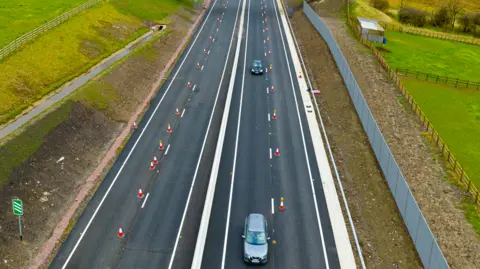The “Road from Hell,” officially known as the A465 Heads of the Valleys road in South Wales, has finally reopened after a lengthy and tumultuous 23-year journey of roadworks and upgrades. This project, dubbed one of the UK’s most expensive and complex road modernizations, was marked by consistent obstacles, including significant budget overruns, construction delays, and periods of disruption resulting from the global pandemic.
On a recent Friday night, the final traffic cone was lifted, marking the end of an arduous £2 billion investment that began in 2002. Spanning 28 miles (approximately 45 kilometers), the upgraded road is intended to boost prosperity in one of the UK’s most economically challenged regions while reducing travel times between West Wales and the Midlands. This infrastructural endeavor aims to stimulate local economies and interconnect communities that were previously hampered by inadequate transportation infrastructure.
However, while Welsh ministers assert that this upgrade will bring considerable benefits to the region, critics have voiced strong disapproval over both the exorbitant cost and the extensive time taken to complete. Dubiously nicknamed the “road from hell,” its infamy largely stems from the frequent tailbacks and accidents that plagued it even before the construction began. The initial upgrade plan was conceived during Margaret Thatcher’s Conservative government in 1990 due to concerns over ongoing traffic issues.
When Tony Blair’s Prime Ministership began in 2002, the work necessary to convert the road into a full-dual carriageway commenced. Following years marked by budget discrepancies, numerous project delays, and the various hurdles posed by the pandemic, drivers finally have the opportunity to traverse the direct route between Swansea and Monmouthshire without navigating through roadworks for the first time in over two decades.
Geographically, the A465 corridor may seem straightforward; however, it uniquely traverses the south Wales coalfields and runs perilously close to residential areas in several parts. The extensive upgrade involved the construction of nearly 70 new structures—over 40 of which are bridges—and a dozen new junctions. As part of the environmental initiatives accompanying the project, workers planted approximately 285,000 trees aimed at offsetting over seven million kilograms of carbon dioxide emissions annually.
Ken Skates, the Transport Secretary, previously stated that in the long-term perspective, this investment will be deemed invaluable for the Heads of the Valleys communities, resonating with hopes for job opportunities, regional growth, and improved connectivity. Despite the optimistic outlook, the financial specifics reveal a hefty price tag. The most recent phases of the project alone set back £590 million for construction, but the financial structure means the total cost will balloon to around £1.4 billion over time.
Plagued with disapproval, the funding methodology has been criticized. Terms like the Mutual Investment Model (MIM) have emerged to explain how the Welsh government aims to alleviate upfront costs, instead committing to annual repayments over a span of 30 years. Critics contend that this approach enriches private firms while depriving public funds that could have been allocated elsewhere.
While the reopening is met with a sigh of relief from many, including those living in affected communities, anecdotal accounts reveal a mixed bag of perceptions. Some locals appreciate the reduced travel times and improved safety, saying it is a long-overdue achievement worth the initial hassle. Others, however, recount the struggles faced during years of ongoing change; learning to navigate the altered road layouts proved challenging for many drivers, particularly new ones.
As Wales heralds the completion of this monumental project, political analyses suggest that such infrastructure endeavors might open pathways for future developments, particularly considering ongoing debates about environmental implications and transport policy adjustments in the wake of climate emergencies. The landscape of Welsh infrastructure appears poised for more transformations, albeit with learned lessons from this lengthy and expensive quest of modernizing the A465 Heads of the Valleys road.



